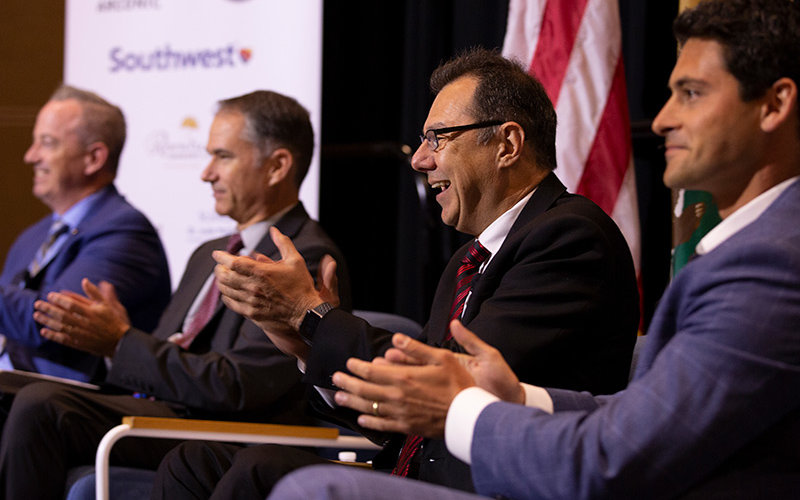
The North Orange County Chamber recently held its State of North Orange County program at Cal State Fullerton and featured city leaders, elected officials and chamber members, as well as CSUF President Fram Virjee and Vice President for Information Technology Amir Dabirian.
The first half of the program addressed the state of the north Orange County, while the second half focused on “smart cities.”
Virjee welcomed the audience to campus and touted the university’s efforts in making sure technology is an essential element in curriculum, communications, workforce development efforts, student success and degree progress.
He also spoke of the role CSUF plays as the “preeminent bridge to upward mobility and workforce development in our region.
“For tens of thousands of students, we are the only bridge,” he emphasized. “We are the bridge to their future prosperity.”
He reiterated that Cal State Fullerton’s core mission is to educate and prepare students for the future … and more than $3 billion of alumni earnings are directly attributable to their degrees. Titans also stay close to home with about 80 percent working or living within 50 miles of north Orange County.
Doug Chaffee, Orange County Fourth District supervisor, spoke of issues affecting north Orange County: water, homelessness, transportation and how to meet the many challenges of the future.
“Relationships are critical to getting things done,” he emphasized. As an example, he pointed to the strides that have been made in dealing with homelessness when cities work together.
“We will have two new navigation centers, what used to be called shelters, for the homeless,” said Chaffee. “One will be in Placentia and the other in Buena Park. We hope to have both finished by February 2020. And since many homeless also need counseling and mental health services in addition to a bed, we are working with the county to develop ‘Be Well’ centers, where all the resources they may need are under one roof.
“By working cooperatively together and seeking both public and private resources, we are able to get things done,” he said.
When it comes to “smart cities,” a panel of IT experts and city managers discussed how this concept is changing the world.
“Connectivity affects how we work, where and when we work, and how we will need to think about our work,” said panel moderator Cherry Li-Bugg, vice chancellor of educational services and technology, North Orange County Community College District. “Half of the population lives in cities or urban areas. By 2050, this is expected to increase to two-thirds. Worldwide, four billion people live in cities and in the United States alone, 81 percent of the population lives in urban areas or the suburbs.”
“Smart cities need to engage with residents, communicate through technology and the more we use it to engage, the better we can do our jobs,” said Jim Vanderpool, city manager of Buena Park. “For instance, we have mobile device platforms where residents can inform us of potholes or downed trees or obstacles.”
“Infrastructure is critical,” added Dabirian. “It’s the foundation for what you do. Establishing policies and guidelines ensures that technology is used effectively and efficiently.”
Ken Dormer, Fullerton city manager, stressed the importance of educating the community — and city council members — about how technology will work, addressing citizens’ concerns, and communicating how cities will prepare to incorporate these new programs and let citizens know of upcoming changes. For example, he endorsed the concept of “dig once,” that is, if streets must be “dug up” for maintenance, crews also might lay the conduit for fiber optic lines.
If public/private partnerships are desired, what types of collaboration work best?
“You need open lines of communication with your various stakeholders,” said Ben Bawtree-Jobson, CEO of SiFi Networks. “When you’re setting up the framework, you might want to ask ‘what’s the art of the possible?’ That’s where collaboration becomes increasingly important.”
Privacy, or lack of, may become potential issues in an increasingly “linked” environment.
“Look at your phones, at your watches,” said Dabirian. “Google knows where you are. We need sound data policies. How will the data be used? In most cases, database owners ‘own’ the data, not individuals. So are people’s rights being respected? And we need to look at cybersecurity. How can we ensure that confidential information is safeguarded? Keeping data safe will be an ongoing concern.”